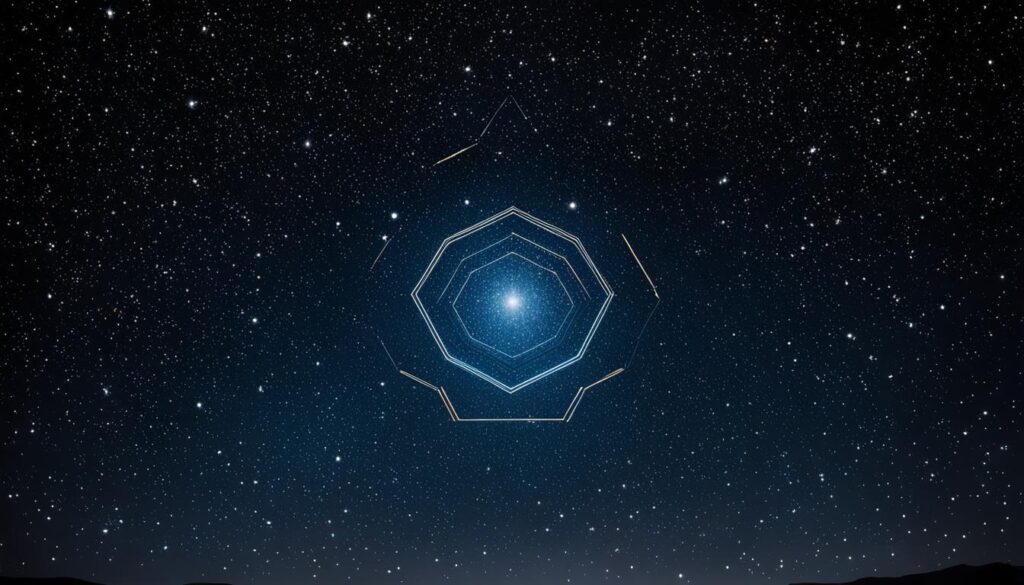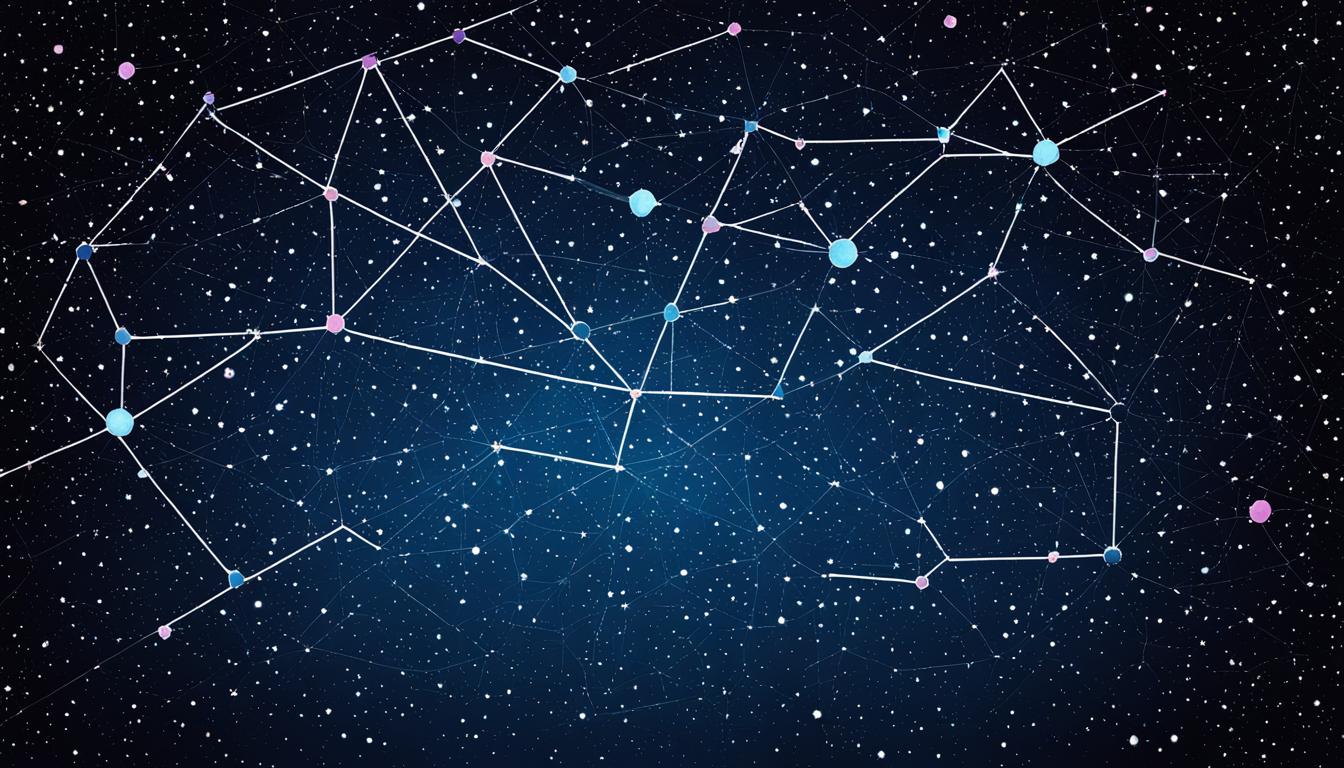As you gaze upon the winter night sky, be prepared to embark on a stellar journey through the Auriga constellation. Known for its striking celestial hexagon, this constellation’s star pattern, famously referred to as Auriga’s hexagon asterism, offers an enthralling sight that has captivated onlookers for generations. The hexagon’s brightest stars – Capella, Menkalinan, Mahasim, Hassaleh, Almaaz, and neighboring Taurus’ Elnath – weave a fascinating narrative against the cosmos. These guiding lights not only enrich our cosmic views but also point the way to astronomical gems, deepening our connection to the universe’s grandeur.
Key Takeaways
- Identify Auriga’s hexagon asterism by its six brightest stars, creating a geometric wonder in the sky.
- Discover how the auriga constellation serves as a celestial compass to uncover hidden deep-sky treasures.
- Experience the rich history and beauty that the celestial hexagon of Auriga has offered to skywatchers throughout time.
- Learn to spot the distinctive star pattern among the stars of Auriga from almost any northern location.
- Revel in the fact that Auriga’s hexagon is a part of the larger Winter Hexagon, adding to its stellar significance.
Unveiling the Auriga Constellation
The tales woven into the night sky through the Auriga constellation are as old as time itself, with the celestial charioteer guiding our gaze upwards. As you explore the star pattern Aurigas, you are diving into a rich narrative set against the cosmos.
The Mythology and History of Auriga
Embark on a celestial journey through history, where the Auriga constellation is drenched in mythological significance. Tracing back to the Almagest by Ptolemy, this group of stars has acted as a beacon of storytelling and wonder. Representing ‘the Charioteer’, it is either associated with Erichthonius, who reinvented the chariot pulled by four horses, or like Myrtilus, the divine son of Hermes. Its position in the heavens was the ancients’ way of honoring these mythical figures for their bravery and intellect.
In epochs past, Auriga’s hexagon asterism also held significance in Babylonian astronomy, often depicted as a goat-herd. This reaffirms how star clusters have been more than just points of light—they’ve been characters in humankind’s greatest stories, etched amongst the stars.
Identifying the Charioteer in the Night Sky
With the celestial hexagon serving as a guide, identifying the Auriga constellation becomes a captivating endeavor. Crowned by Capella, the constellation’s brightest star, it is nestled adjacent to Taurus and Gemini. Pioneers of the past utilized the patterns within Auriga for navigation and as a celestial timekeeper, signaling the changing seasons.
To locate this celestial marvel, find the area spanning between right ascensions of 4 hours 37.5 minutes and 7 hours 30.5 minutes and a declination range from 27.9 to 56.2 degrees north. Here you will encounter the resilient figure of the Charioteer, a sentinel watching over the wintery northern skies, a testament to human curiosity and our perpetual quest to understand the universe.
Exploring Aurigas Hexagon Asterism
The night sky is a mosaic of patterns, and its beauty is crystallized in the form of the hexagon asterism Aurigas. This distinctive stellar hexagon is a unique highlight among the various celestial formations, serving as an iconic part of the winter heavens. With each star serving as a historical marker, your gaze is not just scanning a constellation but traversing centuries of myths and stargazing legacy.
Within the reach of even amateur telescopes, the aurigas hexagon becomes much more than a geometric marvel; it’s a celestial tapestry rich with storytelling. Among the patterns of the night sky, the hexagon asterism in the Auriga constellation stands out for its brightness and significance. Let’s delve into the details that make this asterism as intriguing as it is illustrious:
- Capella: Capella marks the aurigas hexagon as part of the larger Winter Hexagon asterism, shining as the northernmost vertex—and offering an anchor to this celestial landmark.
- Menkalinan: Joining Capella, Menkalinan adds its own tale to the asterism, with its historical name meaning “the shoulder of the rein-holder,” it reinforces the charioteer narrative.
- Elnath: Though technically part of Taurus, Elnath contributes to the hexagon asterism, connecting mythologies and providing yet another brilliant point for stargazers to discover.
The symmetry and splendor of the hexagon asterism Aurigas offer not just a visual treat but also a celestial guide, tracing a line of history as seen in the stories linked to each star. Below, find each star’s magnitude and distance from Earth, expanding your understanding of this impressive asterism:
| Star Name | Magnitude | Distance (Light Years) |
|---|---|---|
| Capella | 0.08 | 42.9 |
| Menkalinan | 1.90 | 81.1 |
| Elnath | 1.65 | 134 |
Remember, when you next venture out on a clear winter’s night, the hexagon asterism aurigas is more than a twinkling geometric oddity—it’s your gateway into the cosmic dance of astronomy.
Stars of the Hexagon: A Celestial Guide
As you delve into the wonders of the auriga constellation, a spotlight on the individual stars composing the aurigas hexagon asterism reveals a narrative of cosmic brilliance and celestial mechanics. The celestial hexagon is not only a pattern of geometric perfection but also a dynamic assortment of eclipsing binary stars and glowing giants, each contributing to the constellation’s lore and luminescence.

Capella: Auriga’s Shining Beacon
Among the many luminaries in the night sky, Capella distinguishes itself as the brightest within the auriga constellation, a quadruple-star system that adorns the apex of the aurigas hexagon asterism. This stellar giant presents itself not as a single entity but a complex ensemble of celestial bodies, contributing to the asterism’s allure.
Menkalinan and the Eclipsing Binaries
Menkalinan, also recognized as Beta Aurigae, punctuates the asterism with its rhythmic variations in luminosity. As an Algol-type eclipsing binary star, its systematic dimming and brightening add a layer of mystique to the constellation’s chandelier, inviting both wonderment and scientific exploration.
The Allure of Almaaz and Hassaleh
The hexagon’s charm is further enriched by the intriguing presence of Almaaz and Hassaleh. To behold Almaaz is to observe an eclipse unraveling within the cosmos, an astronomical phenomenon that captivates and challenges the observer’s gaze. Hassaleh, an orange titan, marks the constellation with indelible radiance, a testament to the incandescent architecture lining the fabric of our galaxy.
| Star Name | Designation | Star Type | Distance (Light-years) | Constellation |
|---|---|---|---|---|
| Capella | Alpha Aurigae | Giant Star | 42.9 | Auriga |
| Menkalinan | Beta Aurigae | Eclipsing Binary Star | 81.1 | Auriga |
| Almaaz | Epsilon Aurigae | Binary Star | 2,000-3,300 | Auriga |
| Hassaleh | Iota Aurigae | Bright Giant | 490 | Auriga |
Navigating the Night Sky: How to Locate Auriga’s Hexagon
If you’ve ever gazed up at the night sky and wished for a guide to unravel its secrets, your journey begins with the aurigas hexagon asterism. This prominent feature within the auriga constellation is not just breathtaking but also an accessible starting point for stargazers. To find this celestial hexagon, it’s essential to understand the stellar coordinates that map the heavens.

Stellar Coordinates: Right Ascension and Declination Defined
Picture the night sky as a vast, spherical map. To successfully navigate this map, astronomers utilize stellar coordinates known as right ascension and declination. Think of right ascension as the celestial equivalent of longitude, and declination akin to latitude. Together, these coordinates allow you to pinpoint any star or constellation, including the auriga constellation‘s hexagon. The hexagon asterism of Auriga is particularly easy to locate, nestled at right ascension 06h 00m 00s and declination +40° 00′ 00″. By aligning your gaze with these coordinates, the celestial hexagon unveils itself, leading you to the clinquant lanes of stars that form Auriga’s hexagon.
Best Viewing Times Throughout the Year
The auriga constellation and its hexagonal asterism offer a yearly celestial highlight for avid sky-watchers. Though this constellation is visible for much of the year in the northern hemisphere, the best viewing times fall within the heart of winter. From the sparkle of January to the crisp nights of February, you’re invited to trace the aurigas hexagon asterism as it climbs to a place of prominence in the evening sky. Within the latitudes of +90 degrees and +40 degrees, the constellation assumes center stage, giving the aurigas hexagon its moment in the cosmic limelight. Mark your calendars, for these winter months ensure the auriga constellation shines its brightest, beckoning observers to revel in its astral charm.
Armed with knowledge of stellar coordinates, right ascension, and declination, along with awareness of the best viewing times auriga constellation, you are now equipped to undertake the rewarding quest of locating the enchanting celestial hexagon in the vast theater of the night sky.
Ancient Meets Modern: Auriga in Astronomy Today
Auriga, the Charioteer constellation, bridges the gap between antiquity and contemporary stargazing. With its deep roots in ancient Greek myth Aurigas, the constellation has journeyed through the ages to secure IAU recognition Auriga constellation, affirming its role in today’s cosmic cartography.
The Auriga’s hexagon asterism, prominent in the field of modern astronomy, is more than a mere cluster of stars. It symbolizes the fusion of history and science, standing as a steadfast sentinel in the night sky.
From Greek Myth to IAU Recognition
Immortalized in the stars, Auriga’s legacy is as luminous as its celestial bodies. Birthed from lore, where it was said to be held in high regard amongst gods and mortals, the constellation’s famed hexagon retains its splendor. The IAU recognition not only serves as a technical nod but also preserves the stories of our ancestors under the same sky they once venerated.
Auriga’s Place Among Neighboring Constellations
Nestled among the recognizable shapes of neighboring constellations Auriga, the charioteer’s hexagon stands as a guidepost for astute observers. The auriga position is strategic, both aiding in the identification of nearby constellations and serving as a waypoint for celestial explorers poised to uncover the mysteries of the universe via telescope or binoculars.
| Constellation | Relation to Auriga | Notable Features |
|---|---|---|
| Taurus | Southwest Border | Includes bright star Aldebaran and the Pleiades cluster |
| Gemini | South Border | Contains the twins Pollux and Castor |
| Lynx | East Border | Fainter constellation, requires dark skies |
| Camelopardalis | North Border | Home to many galaxies due to its position opposite the Milky Way |
The Cosmic Playground: Deep Sky Objects in Auriga
As you peer into the celestial realm of Auriga, you are greeted by a captivating array of deep sky objects that beckon the curious and impassioned stargazer. Hidden within the angular outline of the celestial hexagon, these Messier objects invite you to delve into the stellar nurseries where new stars are born and ancient ones continue to tell their stories. Encountering these wonders is not merely a visual feast but a journey through the history and life of our galaxy.
Messier Marvels: Open Clusters M36, M37, and M38
Amongst the deep sky objects in the Auriga constellation, the open clusters known as M36, M37, and M38 offer a visual spectacle that is both fascinating and informative. Each cluster provides a unique glimpse into the cosmic cohesion of star formations, revealing how gravitational forces bind stars into communal gatherings that span across light-years. Observing these clusters—whether you’re a novice astronomer or a seasoned observer—adds a profound depth to your celestial explorations, bridging the immense scales of space with the human gaze.
The Flaming Star Nebula: A Cosmic Phenomenon
The centerpiece of your deep sky exploration within Auriga is the Flaming Star Nebula. This radiant nebula, with the rogue star AE Aurigae casting its intense light over an interstellar canvas, paints a portrait of cosmic vitality and movement. It stands out as a testament to the active, dynamic processes that drive the evolution of the universe. Witnessing this stellar phenomenon is akin to watching the flames of creation itself—transcendent and eternal against the night sky.
FAQ
What stars make up Auriga’s Hexagon Asterism?
The stars that form the Auriga’s Hexagon Asterism are Capella, Menkalinan, Mahasim, Hassaleh, Almaaz from the Auriga constellation, and Elnath from the neighboring constellation Taurus.
What is the mythology behind the Auriga constellation?
The Auriga constellation is thought to depict ‘the Charioteer,’ which is associated with Greek mythology, representing either Erichthonius, who was credited with inventing the four-horse chariot, or Myrtilus, the son of Hermes. The constellation’s symbolism is rooted in heroism, ingenuity, and celestial recognition of earthly deeds.
How can you identify the Auriga constellation in the night sky?
You can locate the Auriga constellation by searching for its brightest star, Capella, in the northern celestial hemisphere. The constellation can be found between 4 hours 37.5 minutes to 7 hours 30.5 minutes right ascension and 27.9 to 56.2 degrees north declination. It is visible mostly during the winter months in the northern hemisphere.
What is the significance of Capella within Auriga’s Hexagon?
Capella is the sixth brightest star in the sky and the brightest within the Auriga constellation, anchoring the hexagonal shape of the asterism. It is also part of a quadruple-star system, adding depth and interest to this celestial feature.
Why is Menkalinan notable among the stars of the Hexagon?
Menkalinan, or Beta Aurigae, is an Algol-type eclipsing binary star system. Its brightness noticeably varies within a nearly four-day cycle due to the orbital mechanics of its two stars, making it an important object of study for its dynamic behavior.
How do astronomers use right ascension and declination to locate Auriga?
Right ascension and declination are celestial coordinates used much like terrestrial longitude and latitude to locate objects in the night sky. Auriga can be precisely found at celestial coordinates of 06h 00m 00s in right ascension and +40° 00′ 00″ in declination.
When is the best time to view Auriga’s Hexagon Asterism?
The best time to view Auriga’s Hexagon is during the winter months, especially from January through February, when it is visible in the evening sky of the northern hemisphere at its most prominent state.
What is the significance of Auriga’s constellation’s IAU recognition?
The International Astronomical Union (IAU) officially recognizes Auriga with specific borders and a three-letter abbreviation, “Aur,” which serves as a uniform standard for astronomers worldwide when charting and studying this and other constellations.
What deep-sky objects are located within Auriga?
Within Auriga, there are several fascinating deep-sky objects, including the Messier objects M36, M37, and M38, which are open star clusters, as well as the Flaming Star Nebula, a magnificent emission and reflection nebula.
How do neighboring constellations assist in finding Auriga in the night sky?
Neighboring constellations such as Taurus, Gemini, Lynx, and Camelopardalis serve as a frame of reference that assists stargazers in locating Auriga. By identifying these nearby constellations, one can more easily pinpoint the position of Auriga in the celestial landscape.






